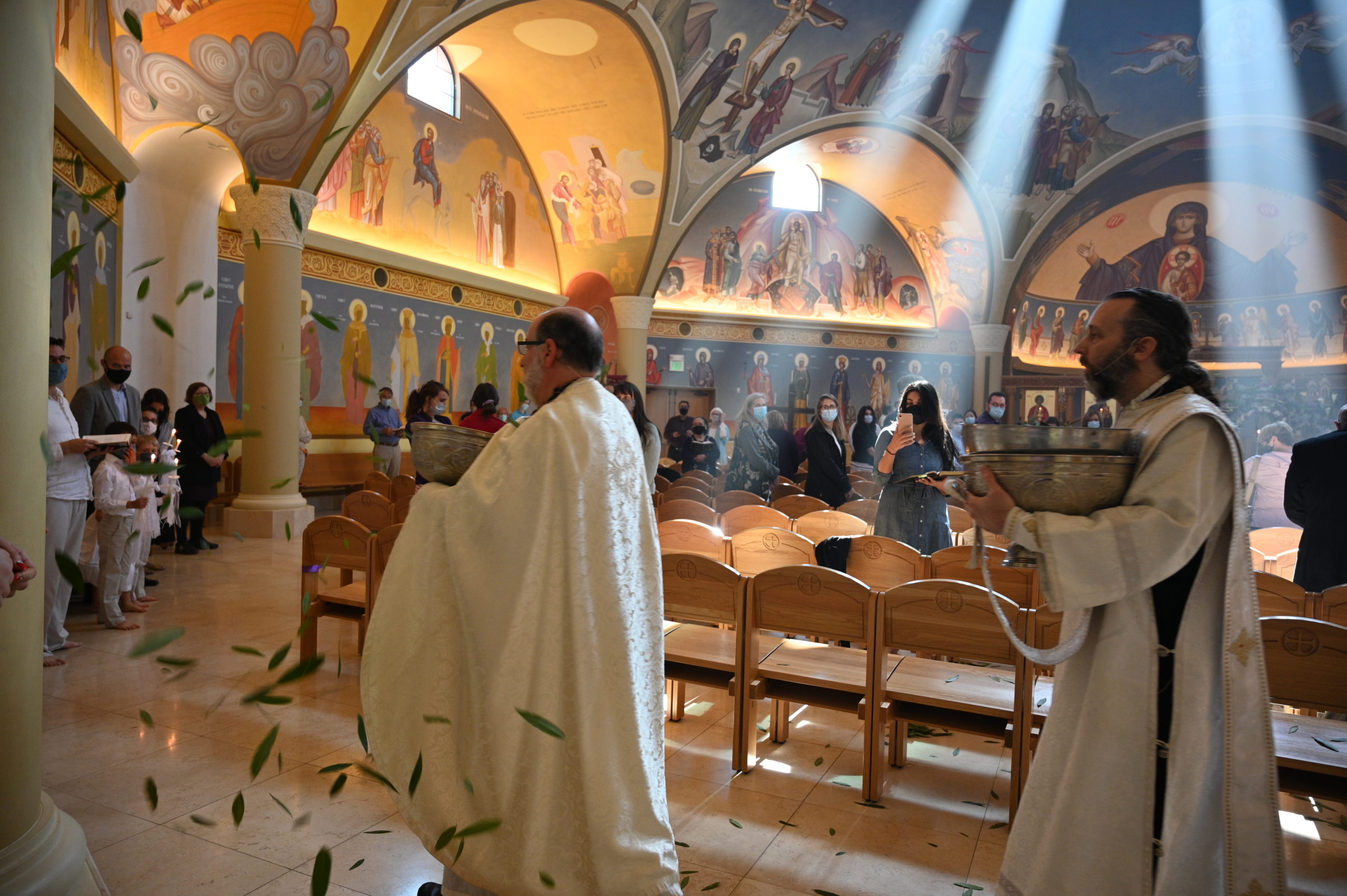On Holy Saturday itself, Vespers are served with the Divine Liturgy of Saint Basil the Great. This service already belongs to the Passover Sunday. It begins in the normal way with the evening psalm, the litany, the hymns following the evening Psalm 141 and the entrance with the singing of the vesperal hymn, Gladsome Light. The celebrant stands at the tomb in which lies the winding-sheet with the image of the Savior in the sleep of death.
Following the evening entrance which is made with the Book of the Gospels, fifteen readings from the Old Testament scriptures are read, all of which relate to God’s work of creation and salvation which has been summed up and fulfilled in the coming of the predicted Messiah. Besides the readings in Genesis about creation, and the passover-exodus of the Israelites in the days of Moses in Exodus, there are selections from the prophecies of Isaiah, Ezekiel, Jeremiah, Daniel, Zephaniah, and Jonah as well as from Joshua and the Books of Kings, the Canticles of Moses, and of the Three Youths found in Daniel are chanted as well.
After the Old Testament readings the celebrant intones the normal liturgical exclamation for the singing of the Thrice-Holy Hymn, but in its place the baptismal verse from Galatians is sung: As many as have been baptized into Christ have put on Christ. Alleluia (Gal 3.27).
As usual in the Divine Liturgy the epistle reading follows at this point. It is the normal baptismal selection of the Orthodox Church (Rom 6.3–11). “If we have been united with him in a death like his we shall certainly be united with him in a resurrection like his” (Rom 6.5).
At this time the royal gates are closed, and the celebrants and altar servers change their robes from the dark vestments of the passion into the bright vestments of Christ’s victory over death. At this time all vestings of the church appointments are also changed into the color signifying Christ’s triumph over sin, the devil and death. This revesting takes place while the people sing the verses of Psalm 82: “Arise O Lord and judge the earth, for to Thee belong all the nations.”
After the solemn chanting of the psalm verses, to which are often added the hymn glorifying Christ as the New Passover, the Living Sacrifice who is slain, the Lamb of God who takes away the sins of the world; the celebrants emerge from the altar to announce over the tomb of Christ the glad tidings of his victorious triumph over death and his command to the apostles: “Make disciples of all nations baptizing them in the name of the Father and of the Son and of the Holy Spirit, teaching them to observe all that I have commanded . . .” (Mt 28.1.20). This Gospel text is also the reading of the baptismal ceremony of the Orthodox Church.
The Divine Liturgy then continues in the brilliance of Christ’s destruction of death. The following song replaces the Cherubic Hymn of the offertory:
Let all mortal flesh keep silent and in fear and trembling stand, pondering nothing earthly-minded. For the King of Kings and the Lord of Lords comes to be slain, to give himself as food to the faithful.
Before him go the ranks of angels: all the principalities and powers, the many-eyed cherubim and the six-winged seraphim, covering their faces, singing the hymn: Alleluia! Alleluia! Alleluia!
In place of the Hymn to the Theotokos, the ninth ode of the matinal canon is sung once again: “Lament not for Me, Mother . . . for I will arise” (see above). The communion hymn is the line of the psalm: “The Lord awoke as one asleep, and arose saving us” (Ps 78.65).
The Divine Liturgy is fulfilled in the communion with him who lies dead in his human body, and yet is enthroned eternally with God the Father; the one who, as the Creator and Life of the World, destroys death by his life-creating death. His tomb—which still stands in the center of the church—is shown to be, as the Liturgy calls it: the fountain of our resurrection.
Originally this Liturgy was the Easter baptismal liturgy of Christians. It remains today as the annual experience for every Christian of his own dying and rising with the Lord.
But if we have died with Christ, we believe that we shall also live with Him. For we know that Christ being raised from the dead will never die again; death no longer has dominion over Him (Rom 6.8–9).
Christ lies dead, yet he is alive. He is in the tomb, but already he is “trampling down death by death, and upon those in the tombs bestowing life.” There is nothing more to do now but to live through the evening of the Blessed Sabbath on which Christ sleeps, awaiting the midnight hour when the Day of our Lord will begin to dawn upon us, and the night full of light will come when we will proclaim with the angel: “He is risen, he is not here; see the tomb where they laid him” (Mk 16.6).
Written by Fr Thomas Hopko in the book, The Orthodox Faith

